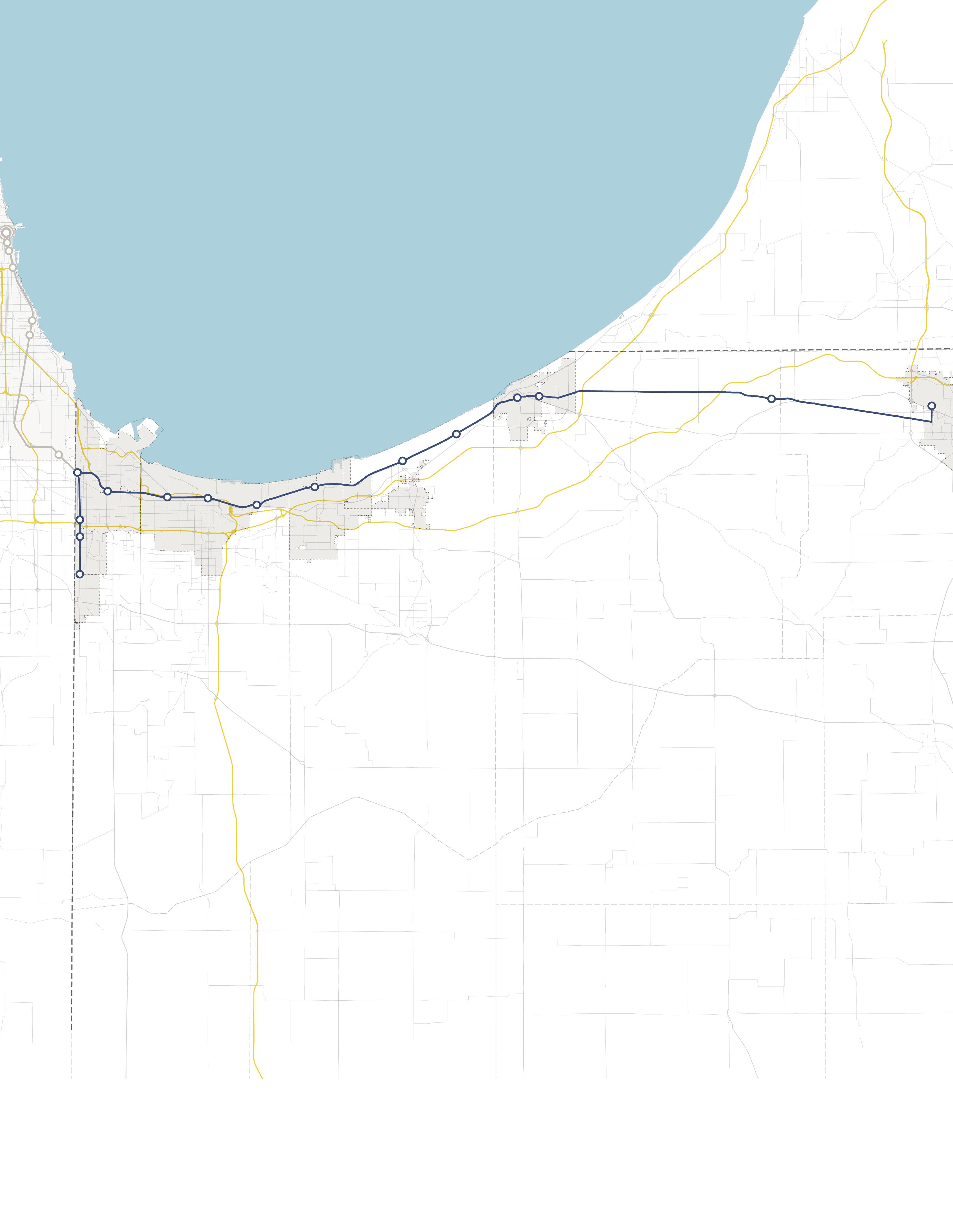

INDIANA INDIANA MICHIGAN ILLINOIS 94 94 80 65 Lake Michigan Hammond Gateway East Chicago Gary Metro Center Miller Portage/ Ogden Dunes 11th Street South Bend Dune Park Beverly Shores Ridge Road Main Street Ridge Road Station 2023
INDIANA TDD TOD Strategic Implementation Plan
NORTHWEST
Acknowledgments
This project was completed with Federal Transit Administration TOD Pilot Planning Funds applied for and with a grant match from the Northwest Indiana Regional Development Authority and the Northern Indiana Commuter Transit District.
Throughout this process, the team worked closely with the Town of Munster to identify and collaboratively advance planning for the community to be proactive about future TOD.
Project Leadership
Northwest Indiana Regional Development Authority




Sherri Ziller, President and CEO
Northern Indiana Commuter Transit District
Michael Noland, President
i
Munster • Ridge Road Station
ii Table of Contents 01 02 03 Introduction TOD Strategy Appendix Introduction 1 Transit-Oriented Development 3 Northwest Indiana TOD Strategy 5 Overview 12 Land Use Planning 21 Development Planning 27 Infrastructure 31 Zoning 45 Implementation 49 Northwest Indiana TDD • TOD Strategic Implementation Plan

01
Introduction 01
Overview
The Northwest Indiana Regional Development Authority (Northwest Indiana RDA) and Northern Indiana Commuter Transit District (NICTD) collaborated in 2020 to pursue a Federal Transit Administration Pilot Grant to provide planning assistance to Northwest Indiana communities impacted by the modernization and double tracking of the NICTD South Shore Line and the construction of the NICTD West Lake Line. With support from the State of Indiana and Northwest Indiana cities and towns, the two organizations successfully obtained this grant and, through a competitive RFP process, selected MKSK as the lead planning consultant to prepare this Northwest Indiana Transit-Oriented Development Strategic Implementation Plan. MKSK brought a team of experts to supplement their planning expertise including: Shrewsberry Associates, focused on Civil, Utility, and Transportation Engineering; Metric Environmental, focused on Environmental Conditions and Brownfields; and Town Planning and Urban Design Collaborative (TPUDC), focused on Zoning.
Project Background
Prior to this planning process, the Northwest Indiana RDA was authorized by the Indiana State Legislature to create economic development boundaries, called Transit Development Districts (TDDs), which function similarly to a Tax-Increment Financing District, with the purpose of enabling Transit-Oriented Development (TOD) in Northwest Indiana. TOD in Northwest Indiana will leverage these rail capital investments to provide the opportunity for additional economic development as part of the TDDs established under HEA 1144-2017. As part of this legislation, the RDA is tasked with “incentivizing, guiding and promoting economic development around the stations along the South Shore commuter line and future West Lake Corridor line.” These boundaries are no more than 320 acres (1/2 square mile) in area; capture the incremental growth in local income and property tax revenue for
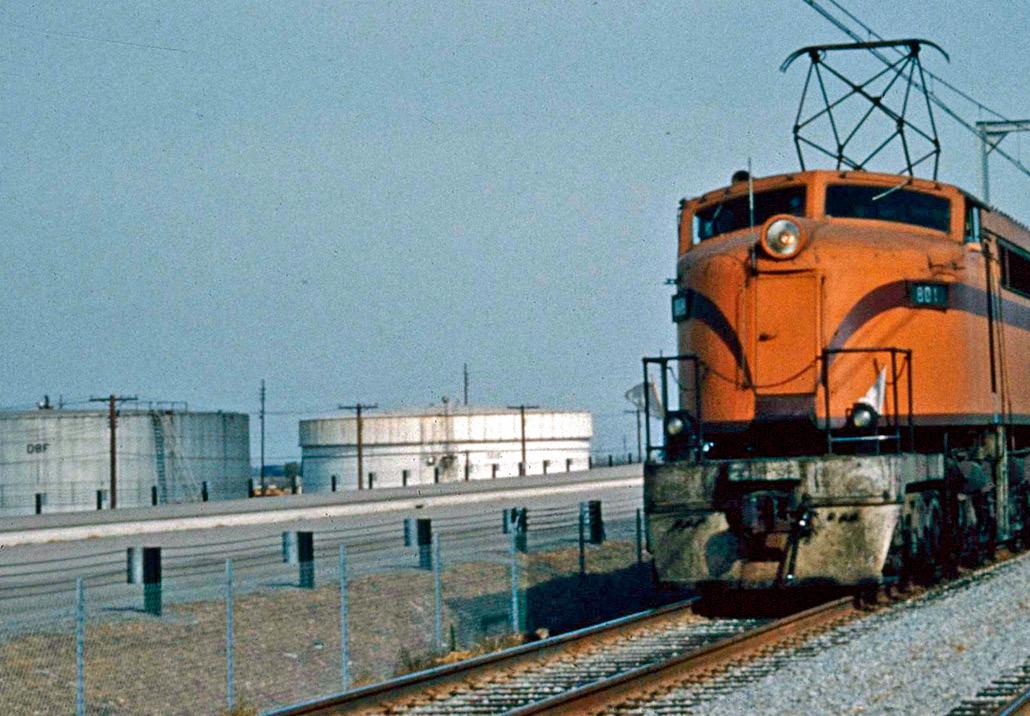
use in public investment related to the station area; and are calibrated specifically for each community based on analysis, areas of opportunity, and the goals and visions of the community. The first group of eight TDDs was established in September of 2022.
This planning process harnessed the momentum generated by the capital improvements to the NICTD commuter rail system and the creation of TDDs. The team, in close collaboration with the RDA and NICTD, then commenced a process focused on how each community impacted with the rail projects and TDDs can be proactive in attracting economic development in accordance with its own growth path. This planning process commenced in September 2021 and was finalized in March 2023.
The communities along the NICTD South Shore and West Lake Lines are diverse and unique. The history, people, natural environment, and built character of each community differentiates it from another; those qualities create an unmistakable identity. In each city and town, there is a deep pride and a sense of individual spirit. Because of this, it is of the highest importance that the growth of these communities be carefully considered against what makes them special today and what their aspirations may be for tomorrow.
The planning process is built upon a deep knowledge of work and a close collaborative relationship with local cities and towns and the RDA’s long-standing commitment to supporting capital investments and economic development in Northwest Indiana. This process also built upon work completed as part of the West Lake Transit-Oriented Development Plan for Hammond, Munster, and Dyer in 2017, completed by the Northwest Indiana Regional Plan Commission (NIRPC), and recent plans completed by local cities and towns.
2 Northwest Indiana TDD • TOD Strategic Implementation Plan
01 Introduction
Transit-Oriented Development
Transit-Oriented Development Primer
Transit-Oriented Development will look different in each Northwest Indiana community, tied to each community’s individual growth path.
The Federal Transit Administration defines Transit-Oriented Development (TOD) as a dense, walkable, mixed-use area centered around or located near a transit station. This concentration of development fosters a vibrant, connected community because of increased access to jobs, amenities, businesses, and housing. TOD also emphasizes non-motorized infrastructure with less reliance on automobiles, resulting in improved safety, congestion mitigation, environmental resiliency, and better quality of life for all.
Benefits of TOD:
• Provides transportation choices and reduces dependence on driving
• Reduces vehicular travel times, congestion, and emissions
• Encourages more walkable cities and towns
• Reduces land consumption for development
• Reduces parking and increases the opportunity for higher/better uses of land
• Provides residents with choices to live, work, and play in the same area
• Expands equitable access to jobs and housing
• Links urban and suburban areas to people and jobs
• Increases housing choices by including a variety of housing types (such as homes on smaller lots, condominiums, townhomes, apartments, etc.)
• Fosters lively community nodes with co-located mix of uses (including all housing types, retail/ shops, restaurants, office, institutional, and commercial)
• Stimulates the revitalization of economically challenged areas
• Increases the potential for community growth and economic activity, stimulates the local economy
• Results in higher state and local tax revenues from increased development opportunity and activity
• Increases a community’s resiliency through a more dynamic mix of uses that makes it less subject to economic volatility
Why is TOD Important for Northwest Indiana?
The historical investment in the NICTD South Shore and West Lake Lines, paired with the ability for TDDs to catalyze development in Northwest Indiana, will be transformative in the communities along the lines. This is a once-in-a-generation opportunity to build upon the public investments (including the $646 million in the Double Track and $852 million in the West Lake capital improvements) to attract economic development to the region through TOD tethered to the country’s third-largest city, Chicago.
TOD will boost the economy of Northwest Indiana and offer new, healthier lifestyle choices for residents of the region’s cities and towns. The modernization of the NICTD commuter rail line will allow for enhanced rail competition with vehicular commuters into the Chicago Loop, bringing the rail commute time equal to, if not faster than, vehicular drive times, and much cheaper than driving and parking in Chicago.
Introduction 3
The RDA’s Comprehensive Strategic Plan estimates $2.7 billion in projected TOD investments in Northwest Indiana due to these rail projects. Many communities are receiving upgraded stations as part of the rail capital improvements. New stations are being constructed in Hammond, Miller (Gary), Michigan City, and Munster; existing stations are being upgraded in Portage/Ogden Dunes and Dune Park. Due to these improvements, TOD projects are already occurring in Michigan City and Hammond, with others to follow. This type of investment has also been happening in the Chicagoland suburbs for decades.
Orland Park Metra Station - SWS Line (2007)
+17% 1.2M +37%
Square Feet of New Construction
Elmhurst Metra Station - UP-W Line (2006)
+11% 640k +40%
Square Feet of New Construction
Highland Park Metra Station - UP-N Line (2009)
0% 640k +43%
Square Feet of New Construction
Romeoville Metra Station - HC Line (2018) 0% 316k +3%
Square Feet of New Construction
Example metrics illustrating the levels and types of investment and impacts occurring in TOD areas in Chicagoland suburbs.
$2.7 Billion in Projected TOD Investments Due to Rail Projects
4 Northwest Indiana TDD • TOD Strategic Implementation Plan 2022 Billions $0.0 $1.0 $2.0 $3.0 2023 2024 2025 2026 2027 2028 2029 2030 2031 2032 2033 2034 2035 2036 2037 2038 2039 2040 2041 South Bend East Chicago Michigan City Munster Dyer Gary Miller Hammond South Gary Metro Hammond Gateway Portage Ogden Dunes Munster Ridge Road
Population Growth Population Growth Population Growth Population Growth Change in Real Estate Value Change in Real Estate Value Change in Real Estate Value Change in Real Estate Value
Northwest Indiana TOD Strategy
Planning Process
This process commenced by bringing the same level of planning assistance to each community impacted by the NICTD South Shore and West Lake Lines, focusing on communities with a TDD boundary in place or with significant economic development opportunities tied to the station area. To accomplish this, a three-step process planning process was employed. This process began with work sessions with each city or town to understand the level of interest and goals for TOD in each community in alignment with their individual growth path.
Through the previous TDD boundary process, the consultant team understood that various factors, such as local political and staff changes, potential catalytic private development, and ongoing planning or infrastructure projects, would impact project work and schedules on a community-by-community basis. To account for these variables, we employed a schedule that begins with a first step of identifying planning needs for each station area.
Based on planning needs and community readiness, we proposed to group station areas to accommodate varying situations and stagger planning activities.
Generally, each community process took approximately 12 months. All of this work was completed between October 2021 and March 2023. During this time, Northwest Indiana RDA and the consultant team met directly with local staff, stakeholders, elected and appointed officials, and the public to solicit feedback and direction for each TOD-focused plan. As a result, individualized community plans have been developed for each study area with supporting appendix materials from technical sub-consultants.
Step 1
Present Previous Findings, Confirm Direction & Establish Priorities
Timeframe: 6-8 weeks
Step 2
Conduct In-Depth Analysis, Advance Development/ Infrastructure Planning & Evaluate Regulating Resources
Timeframe: varies
Step 3
Conduct Individualized Planning Activities & Provide Recommendations and Documentation
Timeframe: varies
CONCURRENT: Public Engagement, Client, Local Officials & Team Meetings
Planning Process Introduction 5
West Lake Line & South Shore Double Track Projects
West Lake Line Project
9 MILES South Shore Line Double Track Project
25 MILES
16 MILES
Communities Studied
The project focused primarily on communities with an established TDD boundary or with a TOD study area. However, high-level assessments were also conducted for communities with stations along the South Shore Line who are eligible for future TDD boundaries. Several stations along the lines were not studied at the request of local leadership in consultation with the Northwest Indiana RDA and NICTD.
South Shore Line
• East Chicago (TDD Boundary)
• Metro Center, Gary (TOD Study Area)
• Miller, Gary (TDD Boundary)
• Portage/Ogden Dunes (Two-Community TDD Boundary)
• Dune Park (High-Level Study)
• Beverly Shores (High-Level Study)
• Michigan City (TDD Boundary)

• South Bend (High-Level Study)
West Lake Line
• Hammond Gateway/Downtown, Hammond (TDD Boundary)
• Ridge Road, Munster (TDD Boundary)
• Main Street, Munster & Dyer (Two-Community TDD Boundary)
NORTH INDIANA INDIANA MICHIGAN ILLINOIS 94 94 80 65 Lake Michigan Lake County Porter County LaPorte County St. Joseph County GARY PORTAGE BURNS HARBOR PORTER CHESTERTON MICHIGAN CITY EAST CHICAGO HAMMOND MUNSTER DYER SOUTH BEND Hammond Gateway East Chicago Gary Metro Center Miller Portage/ Ogden Dunes 11th Street South Bend Dune Park Beverly Shores Ridge Road Main Street 6 Northwest Indiana TDD • TOD Strategic Implementation Plan
Rail Extension
Project Area New Second Track
Scope of Work
To further develop an individualized approach for each community, work plans were created, incorporating specific information desired by the FTA to be included in the planning process and other planning processes at the request of the communities, if any. The Scope of Work Breakdown on the following pages detail the work plan and planning activities in this process.
The following task list organized the work plans:
• Individualized engagement approach
• TOD readiness evaluation
• Previous planning gaps and opportunities
• TOD types and community priorities
• Potential areas of impact (TOD areas and other areas of anticipated significant change)
• Future land use projections (5-, 10- , 20-year time horizons)
• Development feasibility testing and potential community impacts
• Development character renderings
• Thoroughfare typology assignments
• Conceptual corridor designs
• Brownfield assessments
• Infrastructure assessments
• Zoning code/ordinance analysis and recommendations
• Order of magnitude infrastructure and corridor cost estimates
• Additional tasks as requested by individual communities, which may consist of corridor/ connectivity planning, neighborhood/subarea planning, additional engagement activities, additional site concept designs and/or renderings, development pitch kits, open space and trail planning, case study research, additional conceptual street design, capacity building, action planning, and one-year follow-up summaries
Scope Items
Planning Needs and Gaps Analysis
Land Use & Zoning Review and Recommendations
Environmental Assessment and Recommendations
Transportation Assessment and Recommendations
Infrastructure Assessment and Recommendations
Development Testing
Capital Improvements Plan
On-Going Efforts
Coordination with NICTD
Stakeholder and Public Engagement
Introduction 7
Planning Needs and Gaps Analysis
• Confirm framework plan direction by correlating objectives from previously completed plans with the community’s current future vision
• Identify gaps and opportunities not addressed in local planning based on previously completed plans
• Determine and prioritize planning needs for future development and recommendations
Land Use & Zoning Review and Recommendations
• Record and analyze current land use and zoning ordinances
• Identify potential changes in land use and zoning ordinances to achieve desired future development
• Coordinate zoning with planning concepts and planned land uses

• Draft zoning code revisions and/or design guidelines to promote future TOD
• Draft regulating plan/zoning map

• RDA consultants will take zoning through process for adoption by local entities
Environmental Assessment and Recommendations
• Limited assessment of sites with potential or known environmental/brownfield concerns
Transportation Assessment and Recommendations
• Corridor and connectivity planning that improves access and walkability to the station area
Infrastructure Assessment and Recommendations
• Evaluating stormwater, utility, road, and pedestrian facilities at site and district scales

Scope of Work Breakdown
8 Northwest Indiana TDD • TOD Strategic Implementation Plan
Development Testing
• Identify up to eight priority development sites per station area (each “site” up to 10 acres)
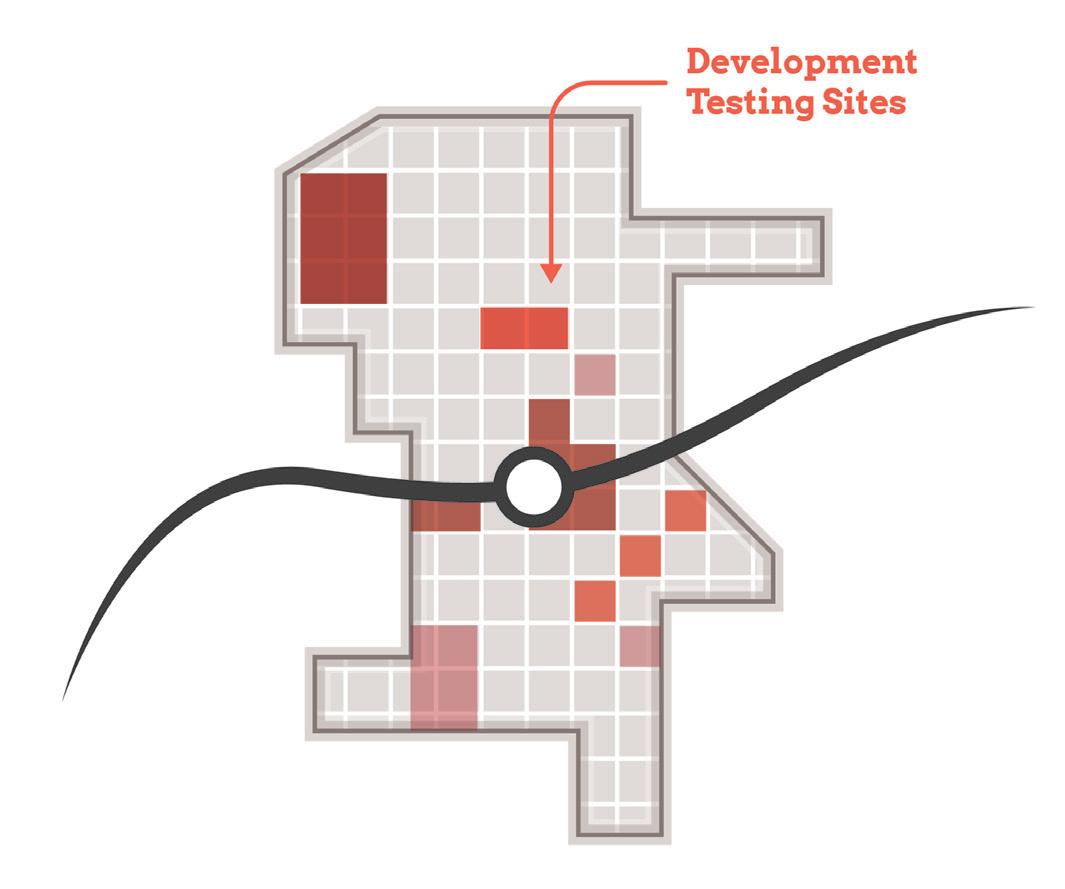
• Test development scenarios for priority sites
• Assess potential site uses based on land use projections and market understanding
• Develop conceptual site plans and three dimensional massing illustrations showing potential infill and redevelopment
Capital Improvements Plan
• Order of magnitude cost estimates for infrastructure improvements and projects to effectuate development (with close collaboration with local units)

Scope of Work Breakdown
Introduction 9
TOD Readiness
At the onset of the process, the team acknowledged that each community differed in its potential for TOD as a result of existing policies and infrastructure in place that are necessary to enable TOD, referred to as TOD readiness. To diagnose each community’s TOD readiness, a matrix was developed to evaluate factors of TOD readiness and was completed in collaboration with local officials. In addition, NICTD completed TOD assessments, which were consulted as these evaluations were completed.
TOD Readiness Criteria
• NICTD Station currently operational or under construction
• TDD Boundary is adopted or the community is eligible for a TDD Boundary
• Adopted policy documents that address or plan for TOD (i.e. comprehensive plan, neighborhood plan)
• Adopted zoning ordinances (or overlays) that address or plan for TOD
• Existing walkable grid as part of a downtown or mixed-use neighborhood that connects or can connect to the station
• Currently operational/planned trail or multi-modal infrastructure
• Existing urban amenities that are walkable and/ or within 1/2 mile of the station (i.e. restaurants, grocery, drug stores, office, parks/plazas)
• Existing dense and quality housing stock (more than eight dwelling units/acre), including rowhouses/townhomes, apartments, condos, and ADUs
• Vacant developable sites within TDD Boundary
• Local unit has demonstrated additional initiatives to support TOD
• Current infrastructure has the capacity to support additional development or TOD
Anticipated Results
At the conclusion of this process, control of local land use and zoning remains with the cities and towns. This process aims to provide proactive guidance and recommendations that the local units can use to advance their planning processes, resulting in updated comprehensive plans, area plans, and zoning ordinances complete with locally-controlled public input. In addition, components of this study are designed in a highly-graphic format to inform development discussions, potential RFP’s, and grant applications.
Each community-specific section will function as a standalone plan that is meant to be pulled out of the overall regional plan and referenced by officials of local cities and towns, public members, and the development community. This information is supplemented by more technical information in the respective appendices.
10 Northwest Indiana TDD • TOD Strategic Implementation Plan
02 TOD Strategy 02

Munster Ridge Road 02
Overview
The Ridge Road Station in Munster is an important investment in Munster’s Ridge Road commercial corridor and established early 20th century neighborhoods around the station and Ridge Road. The TOD opportunity around the Ridge Road Station Area is set up perfectly for small-scale mixed-use development along the Ridge Road corridor complementary to continued preservation and investment efforts in residential areas surrounding the station between Calumet Avenue and the Indiana-Illinois State Line. Walkability to the station and to Ridge Road is a key component of creating a TOD in the Town of Munster.
The Town of Munster is going through a comprehensive plan update that will further define the direction for TOD aligned with the Town’s economic growth path. The town’s vision for TOD is further supported by the 2021 Munster Zoning Code update and the 2021 Calumet-Ridge Streetscape Plan. In order to accommodate additional development within this TDD boundary, growth should be intentional and well-informed by an understanding of capital and personnel costs associated with necessary utility upgrades.
This section focuses on the materials and recommendations that will prepare the Town of Munster to update its plans and to advance its pursuit of TOD as a community gateway for the new West Lake Line. Once operational, the NICTD station at Ridge Road will have a lesser commute time (estimated 45-minutes) to Chicago Loop than most Illinois suburbs.

12 Northwest Indiana TDD • TOD Strategic Implementation Plan
TOD Readiness
The Town of Munster understands the potential for TOD around the Ridge Road Station and seeks to balance this opportunity with the Town’s desire to adhere to its soon to be updated comprehensive plan and recently updated zoning code. The Town is in the process of implementing its 2021 Calumet-Ridge Streetscape plan with funded Complete Street investments on Ridge Road. These investments set the stage for development in alignment with the Town’s economic development growth path. The Town continues to invest in enabling steps to allow it to fully realize the potential TOD opportunities around the Ridge Road Station Area while maintaining its existing small-town appeal. This document serves as a roadmap for TOD implementation by providing recommendations for land use, development, zoning, and infrastructure investments.
Evaluation Criteria
NICTD Station currently operational or under construction
TDD Boundary is adopted or the community is eligible for a TDD Boundary
Adopted zoning ordinances (or overlays) that address or plan for TOD
Adopted policy documents that address or plan for TOD (i.e. comprehensive plan, neighborhood plan)
Existing walkable grid as part of a downtown or mixed-use neighborhood that connects or can connect to the station
Currently operational/planned trail or multi-modal infrastructure
Existing urban amenities that are walkable/within 1/2 mile of the station (i.e. restaurants, grocery, drug stores, office, parks/plazas)
Existing dense and quality housing stock (more than 8 dwelling units/acre), including rowhouses/ townhomes, apartments, condos, and ADUs
Vacant developable sites within TDD Boundary
Local unit has demonstrated additional initiatives to support TOD
Current infrastructure has the capacity to support TOD/additional development
Munster • Ridge Road Station 13
Community Priorities
Community priorities were developed by working closely with Town officials to confirm economic development goals, identify key sites of interest, and understand recent and ongoing municipal and development projects. These priorities form a future vision for the TDD Boundary area specific to the Future Ridge Road Station, which include the following:
• Context sensitive preservation of existing uses and mixed-use development focused around the Future Ridge Road Station
• Mixed-use infill/redevelopment along Ridge Road to complement the existing commercial corridor
• Trail connectivity to the Monon Trail from the station
• Enhancement of Ridge Road and Calumet Avenue through streetscape design and traffic calming to attract private investment
• Ensuring the community develops in accordance with the Comprehensive Plan update and 2021 Zoning Code update
• Testing potential development against utility availability, municipal services, and school capacity
Big Moves
“Big Moves” are defined as enabling steps to signal to the market that conditions are right for transit-oriented development to occur. The opportunity for small to medium scale redevelopment exists around the immediate station area. Walkability should be enhanced to the station area from nearby traditional neighborhoods and commercial corridors. Multiple opportunity sites for mixed-use development also exist along Ridge Road. Development should be complementary to the existing walkable commercial area and residential neighborhoods around the station. Ridge Road and Calumet Avenue streetscape improvements have been planned and designed for these two important commercial corridors. The Munster community has the unique ability to attract multiple housing types such as duplexes, townhomes, and condo that already exist in Town near the station area.
14 Northwest Indiana TDD • TOD Strategic Implementation Plan
Ridge Road TOD Corridor Improvements
Several sites at the key intersection of the Monon Trail, Ridge Road, and the future West Lake Line have potential for high-quality mixed-use development. Additional development of multiple housing types that currently exist in Town as well as commercial uses could enhance existing neighborhoods and serve both the community and rail commuters.

Two important commercial corridors, Ridge Road and Calumet Avenue, provide essential commercial businesses and services to the community. The town’s planned streetscape improvements for both corridors will establish a sense of place and increase walkablility around the station area.
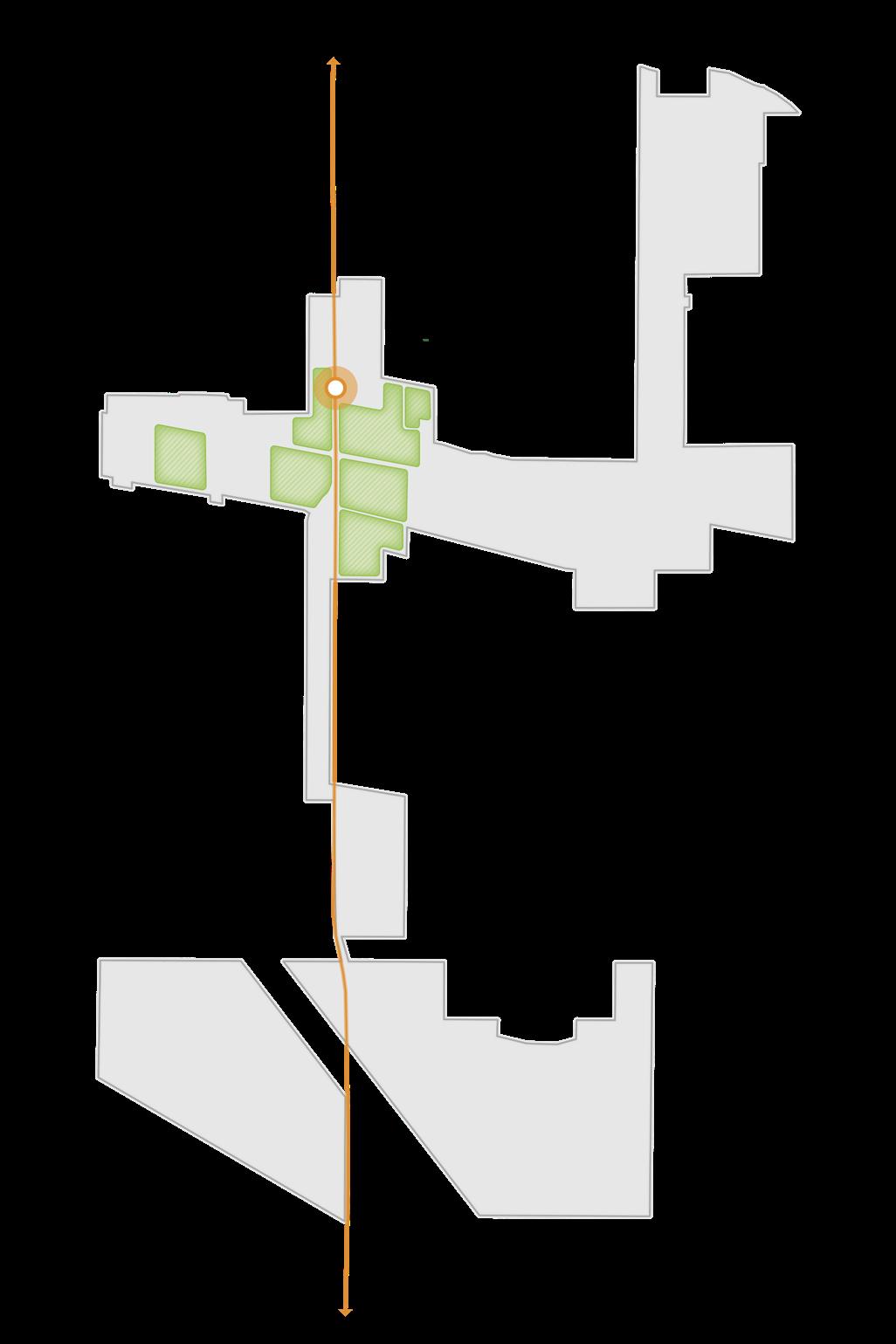
Big Moves Munster • Ridge Road Station 15
NORTH Ridge Road Manor Ave Calumet Ave Ridge Road Manor Ave Calumet Ave West Lake Line West Lake Line
Complementary Commercial
Infill sites and redevelopment opportunities exist along Ridge Road, which should be complementary to the established commercial corridor and surrounding residential neighborhoods.

Big Moves 16 Northwest Indiana TDD • TOD Strategic Implementation Plan
NORTH
Ridge Road
Manor Ave Calumet Ave West Lake Line
TOD Opportunity
An overall TOD Opportunity vision was developed with the Town of Munster outlining the development and investment potential within the TDD boundary area. Opportunity sites were identified as Areas of Impact within each TDD boundary that have the greatest development potential. Characteristics such as cleared sites, underutilized land or surface parking lots, buildings suitable for adaptive reuse, or consolidated or municipal land ownership were important factors determining certain sites’ development potential.
Transit-oriented development opportunity for medium-density mixed-use exists around the immediate station area. Walkability should be enhanced to the station area from nearby traditional neighborhoods and commercial corridors. Multiple opportunity sites for mixed-use development also exist along Ridge Road. Development should be complementary to the existing walkable commercial area and residential neighborhoods around the station. Ridge Road and Calumet Avenue streetscape improvements have been planned and designed for these two important commercial corridors. The Munster community has the unique ability to attract multiple housing types such as duplexes, townhomes, and condos that already exist in Town near the station area.
Areas of Impact
Areas of Impact were established to distinguish between major (re)development areas, both TOD and non-TOD, and areas to be maintained, preserved, and enhanced. These designations begin to direct development activity and other targeted investments based on proximity and relationship to the station area. For purposes of this study, individual sites may have been grouped to demonstrate synergy among sites for development potential.
TOD Opportunity Sites
These areas are prime sites for transit-oriented development due to their proximity and connectivity to the station area. Development of these sites should be dense and urban in form, promote walkability and multi-modal access, and emphasize a quality public realm and sense of place. Access to the station area is crucial in these areas. Development should be mixed-use, integrating a variety of active ground-floor commercial uses and upper-floor uses within a building and integrating a variety of uses in a collection of buildings on a site.
Site B2
Site B2 is a total of 4.5 developable acres, including 3.9 acres of vacant cleared land. Primary access to the site is via an entrance on Ridge Road at the signalized intersection of Ridge Road and Hohman Avenue; a secondary entrance is along Ridge Road. The current use as a dry cleaner likely requires an environmental study for potential hazards or contamination.
Site B3
Site B3 is a 3.9-acre site with a single owner, located at the key intersection of Ridge Road and Manor Avenue, the Monon Trail, and the future West Lake Line. The site contains two structures, a strip mall and a smaller restaurant building, along with a large surface parking lot. Primary access to the site is via an entrance on Ridge Road at the signalized intersection of Ridge Road and Manor Avenue; a secondary entrance is along Ridge Road. The proximity of this site to the Monon Trail makes it highly desirable for retail, residential, and office uses.
Site C2
Site C2 benefits from frontage along Ridge Road, the future West Lake Line, and 30th Place. Harrison Avenue currently bisects the site. Site C2 is 6.2 acres and includes 13 parcels with multiple owners. Several structures exist on the site including three commercial buildings, eight single-family homes, and two vacant buildings. The site is accessible from Ridge Road and Harrison Avenue.
Site C3
Site C3 consists of two parcels with two owners at a total of two acres. The entire site is vacant land with the current use being residential. The site is accessible via 30th Place and does not have frontage on Ridge Road.
Site C5
Site C5 is 4.4 acres of developable land, which includes land reserved for NICTD commuter surface parking lots to the north. A portion of the site is owned by multiple owners, and 30 parcels are being acquired for NICTD’s parking lot. The majority of the site consists of vacant land, and the remainder is office and commercial in use. The site is in a prime location at the intersection of Ridge Road and Manor Avenue, with frontage along Monon Trail as well; this site is also adjacent to the future station.
17 Munster • Ridge Road Station
NOTE: Sites indicated here illustrate the potential for future redevelopment interest based on TOD best practices and market research. None of these sites are recommended for public acquisition by the local unit and are subject to interest from the private real-estate market and the town’s applicable ordinances.
Areas of Impact
Future transit-oriented development is recommended to focus on the Ridge Road corridor surrounding the future station and rail corridor. Several sites immediately surrounding the Future Ridge Road Station and the Ridge Road corridor have been identified as having potential for (re)development.

TOD Opportunity Site Area of Significant Change NORTH 18 Northwest Indiana TDD • TOD Strategic Implementation Plan West Lake Line Future Ridge Road Station Munster Christian Church Community Hospital Munster High School Calumet Center Ridge Rd Calumet Ave Calumet Ave Harrison Ave Manor Ave Manor Ave Hohman Ave Hohman Ave Wentworth Ave Fisher St Columbia Ave Columbia Ave INDIANA ILLINOIS State Line Broadmoor Ave 1/2Mile MUNSTERHAMMOND CorporateLimits Little Calumet River Site C-3 2.0 Total Acres Site D-1 5.5 Total Acres Site C-5 2.8 Total Acres Site B-2 5.2 Total Acres Site B-3 4.3 Total Acres Site D-2 4.5 Total Acres Site C-2 5.2 Total Acres Site E 58.3 Total Acres C C B D D B C E
Site D1
Site D1 totals 4.1 acres, with 1.5 acres being vacant land. Existing structures include a gas station/ convenience market, two restaurants along Ridge Road, and three residential homes along Harrison Avenue. The site has street frontage and access along three sides (Ridge Road, Harrison Avenue, and South Street) as well as frontage along the Monon Trail. The proximity of this site to the Monon Trail makes it highly desirable for retail, residential, and office uses.
Site D2
Also located along the Monon Trail, Site D2 is 4.1 acres consisting of multiple parcels with multiple different owners. All of the properties on the site are single-family residential homes. The site is accessible via Harrison Avenue and South Street, but does not have frontage along Ridge Road.
Areas of Significant Change (Non-TOD)
These areas have been identified for their potential for redevelopment and a major change in use and/ or form. These areas are outside the walkable area surrounding the station – therefore not TOD – but high-quality development of these sites is possible and will significantly impact the community. These areas may be identified for several reasons: they have been included in development planning in this plan but are not proximate to the station; they may have development planning efforts ongoing outside of this plan; or there may be a high potential for future development in the long term that has not been studied yet. Development of these sites may require changes in land use, updates to zoning designation and/or regulations, infrastructure upgrades, or environmental review.
Site E
Site E is 58.3 Acres and is located along the West Lake Line. Constraints of this site include the Indiana/Ilinois border to the west, the future West Lake Line to the east, and a small lake to the north. Directly across the West Lake Line is a NIPSCO substation servicing the Town of Munster. This site includes the vacant Lansing Country Club, the associated golf course, and a natural gas company building. It is largely undeveloped due to the country club’s previous presence.
Areas to Maintain and Invest
All other areas within the TDD boundary not identified for future development investment opportunities should be targeted for enhancement and preservation efforts that protect the existing character and build upon the strengths or existing assets. These areas may look like stable and established neighborhoods or active commercial nodes. Opportunities for small infill development or rehabilitation of structures may be present in these areas but should occur with a focus on compatibility with the surrounding context and land uses.
TOD Types
Transit-Oriented Development (TOD) types are not prescriptive of future land use or zoning but instead describe the vision for creating a place with a focus on vibrancy, an ecosystem with walkability, transit access, and a diverse range of businesses, things to do, and housing can help create. These descriptions describe, at a glance, what TOD potential could be in Northwest Indiana communities and what that might look like. These descriptions have an overarching intent statement and describe typical uses and goals for visually how development or redevelopment could function in each of these areas. Short statements are paired with character imagery from other similar places to help people visualize these TOD types.
Future TOD in Munster’s Ridge Road area is envisioned as a Village TOD Type. The following description explain the key considerations of the TOD Type.
Munster • Ridge Road Station 19
Compact, walkable areas with scaled mixed-use buildings that engage and support an active public realm serving the entire community



TOD Types
Typical Land Uses
Multi-Family Housing; Supportive Housing; Attached Housing; Retail/Offices/Services; Flex Office/Employment; Medical Offices/Services; Government/Public Facilities; Hospitality; Entertainment; Mixed-Use (vertically and horizontally integrated); Surface and Structured
Secondary Land Uses
Pocket Parks/Plazas; Greenways/Trails; Recreation Facilities; Cultural/Civic; Religious, Education, and Assembly Facilities; Floodplain/ Floodway; Preservation/Conservation Area
Parking
On-street parking with limited clustered off-street parking; shared public parking lots and structures with short- and long-term bike parking
Transportation
Typical Building Heights/ Density
Interconnected street grid with wide sidewalks, bike facilities, and frequent bus/transit connections
Medium density of 12-15 dwelling units per acre; 2 stories minimum; anticipated average height of 3-4+ stories
Infill / Redevelopment
Infill should continue the existing visual pattern, rhythm or orientation of surrounding context along the street while adding appropriate height and density. Historically significant or contributing buildings should preserved or adaptively reused when possible.

Other Considerations
Any redevelopment should occur in a sustainable manner that minimizes impacts on natural areas, incorporates proper stormwater management, and mitigates potential hazards to air or water quality.
Northwest Indiana TDD
Village TOD
Land Use Planning
Documentation and Analysis
Previous Planning
Relevant recommendations from the Town’s 2019 Zoning Code (updated 2021) and 2021 Calumet-Ridge Streetscape Plan were documented and incorporated into the recommendations for this process. The Town is currently updating its comprehensive plan, and the 2023 Comprehensive Plan Existing Conditions Report from that process was referenced during this study.

Gaps and Opportunities
A review of previous land use planning from relevant completed plans for each community was conducted to understand where common themes lie across years of land planning and where ideas of land use have evolved over time or may conflict with each other. The review resulted in identifying opportunities that were consistent across many plans and in line with current community goals.
Gaps were identified as areas within the TDD boundaries that have not been studied in great detail in the past but may have future development potential and should be considered to be studied. Gaps and Opportunities were reviewed by each community to determine which land planning thoughts should be carried forward into this land use planning process.
Development and land use planning around Ridge Road was influenced by the location of the future train station. Mixed-use transit-oriented development has been focused around the immediate Ridge Road Station area. Mixed-use infill development opportunities have been considered along the Ridge Road corridor to complement existing commercial uses. Ridge Road and Calumet Avenue are both important corridors to this area and have been studied for streetscape design and traffic calming. As the Town updates its comprehensive plan these opportunities will likely be further refined.
Munster • Ridge Road Station 21
Sites Studied Areas with Similar Future Uses in 2+ Plans Areas with Varied Future Uses in 2+ Plans Gaps and Opportunities Analysis of previous plans affecting the TDD boundary NORTH
2019 Zoning Code (updated 2021)
The Town’s character-based zoning code supports TOD primarily along the Ridge Road corridor and the Monon Trail. The Urban Center zoning has been applied to portion of Ridge Road, then density steps down to General Urban and One- and Two-Family Residential. two-family residential. Since its adoption in 2019, the Town has required additional approvals for mixed-use projects. The Town’s comprehensive planning process will update the 2010 Comprehensive Plan which recommended TOD, but with the station being proposed at a different location. The new comprehensive plan will provide the Town with a foundation for TOD aligned with the community’s economic growth path. Zoning recommendations included in this study focused on updating parking standards to better prepare for realities around development in the Ridge Road Station Area.
2021 Calumet-Ridge Streetscape Plan


The town recently received a RAISE (Rebuilding American Infrastructure with Sustainability and Equity) Grant to help pay for the implementation of recommendations to improve Ridge Road. The streetscape plan proposes a three-lane road instead of five-lane; a 10-foot-wide multi-use path on the south side of the street; more than 250 street trees; and amenities including landscaping, gateway and wayfinding signage, and seating. This streetscape implementation likely will spur significant economic development along this corridor complementary to TOD around the station area.
Relevant Recommendations include:
• Achieve a balanced allocation of space across transportation modes in accordance with demand and community objectives
• Improve safety for people walking and biking
• Maintain acceptable traffic flow
• Better connect residents and visitors to corridor destinations
• Reinforce a sense of place
22 Northwest Indiana TDD • TOD Strategic Implementation Plan
Proposed Ridge Road Streetscape
Proposed Ridge Road Streetscape
Existing Land Use
Existing land uses near the Ridge Road Station primarily consist of commercial uses oriented along Ridge Road and Calumet Avenue. Some multi-family residential areas exist along the Monon Trail, where the future West Lake Line is planned. Beyond the primary commercial corridors exists single-family residential areas.
23 Munster • Ridge Road Station
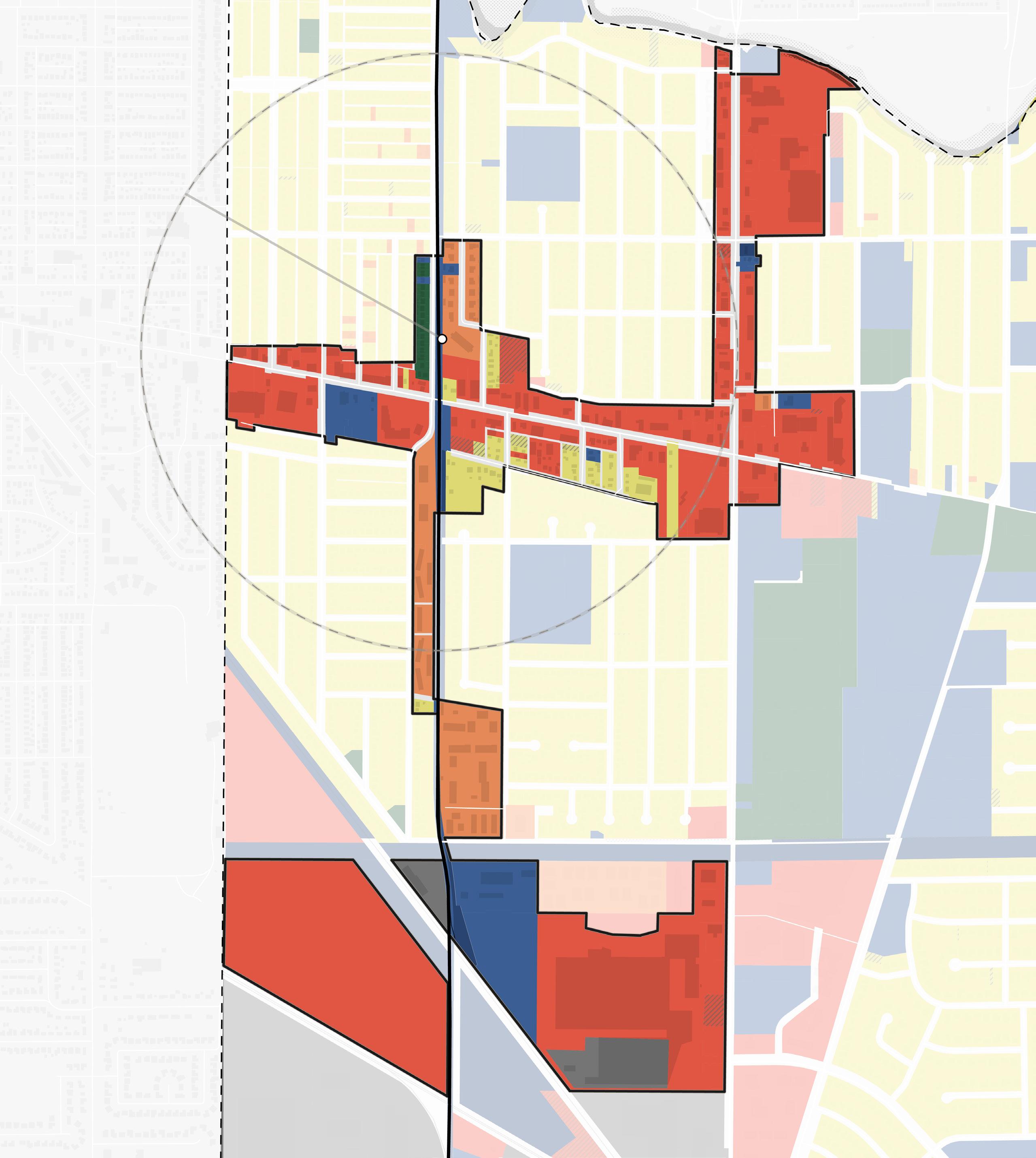
Single-Family Residential Multi-Family Residential Commercial Public Utility and ROW Park District Industrial Vacant Residential Vacant Commercial NORTH 24 Northwest Indiana TDD • TOD Strategic Implementation Plan West Lake Line Future Ridge Road Station Munster Christian Church Community Hospital Munster High School Calumet Center Ridge Rd Calumet Ave Calumet Ave Harrison Ave Manor Ave Manor Ave Hohman Ave Hohman Ave Wentworth Ave Fisher St Columbia Ave Columbia Ave INDIANA ILLINOIS State Line Broadmoor Ave 1/2Mile Little Calumet River MUNSTERHAMMOND CorporateLimits Existing Land Use
Future Land Use
The approach to future land use planning in this plan focuses on areas that are anticipated to change. Future land use is shown in general categories of land use to guide future land use and development decisions while allowing for flexibility in densities and building types. These land use descriptions also illustrate a general character and scale of the built environment recommended as most appropriate. Other areas within the TDD boundaries that are not anticipated to change are not included in future land use planning. More detailed projections over 5-, 10-, and 20-year time horizons are mapped out for specific development sites included in this plan to represent a phased approach to development and land use.
Future land use establishes Mixed-Use Core areas immediately surrounding the Future Ridge Road Station and Ridge Road. A portion of land to the west of the future West Lake Line is reserved as Station Area land use for surface commuter parking. Opportunities for Mixed-Use Neighborhoods exist further along Ridge Road. Beyond Ridge Road, land uses transition into residential neighborhoods as Mixed Residential. The future of the Lansing Country Club is anticipated to redevelop as Employment/ Office uses. There is potential for Mixed-Use Core development with Industrial/Warehousing to enhance the Lake Business Center.
Station Area
The Station Area use applies to the immediate land surrounding the NICTD Rail Station. This area includes the station platform, transit centers or amenities, parking lots or structures for transit riders, and maintenance yards. In the long term, some station areas may have the ability for Mixed-Use Joint Development to occur.
Mixed-Use Core
Mixed-Use Core land uses consist of high-density mixed-use areas, such as downtowns, are characterized by compact block patterns and tall mixed-use buildings. Businesses, services, and institutions serve the immediate residential population and the entire community. Buildings are oriented to the sidewalk, with attractive and active ground floor uses that support and encourage pedestrian activity. Plazas, pocket parks, sidewalks, or activated alleys should serve as public spaces for residents, employees, and visitors.
Mixed-Use Neighborhood
Mixed-Use Neighborhood land uses are medium-scale mixed-use areas that are often called town or village centers. They typically have compact development emphasizing connectivity and walkability with an accommodating public realm and storefronts that engage the street/pedestrians. The development pattern should be of appropriate scale in relation to the street and may include vertically integrated uses and horizontally integrated uses. Plazas, pocket parks, sidewalks, or activated alleys should serve as public spaces for residents, employees, and visitors. This typology provides retail and services to surrounding neighborhoods in a pedestrian-friendly environment, making it possible to accomplish several errands in a single trip.
Mixed Residential
Mixed Residential areas are primarily residential in uses of varying densities and housing types and can be adjacent to complementary commercial or public uses that support residential life. Housing types can range from single-family homes to townhomes and duplexes to multi-family buildings. Streets should be well-connected and be designed with sidewalks or paths and street trees. These areas can be served by neighborhood-scale parks and/or community-scale parks or recreation amenities that are easily accessible by residents, and residential developments can include small open spaces serving residents immediately adjacent to the building. Residential areas may be supported by a variety of nearby neighborhood-serving businesses.
Industrial/Warehousing
Long-term light and heavy industrial uses that are characterized by operations for production, warehousing, distribution, etc. Heavier industrial uses may be more intense and should be concentrated in areas separated and buffered from other land uses. Where possible, industrial or truck traffic should be separated from local/ residential traffic. In the case of lighter industrial, such as artisan manufacturing or small tech centers, these uses may be located adjacent to other uses, such as office/employment or retail/services, without causing compatibility or nuisance issues.
Employment/Office
Employment/Office uses are areas that are dedicated to commercial office spaces, light industrial, and flex spaces, typically as standalone campus-like or office park-like development or destination. This use exists for a specific purpose or serves a particular population and is a major trip generator for a single site (i.e. business parks, flex manufacturing, etc.) Concentrated employment areas may be supported by a variety of nearby businesses targeted toward serving the daytime population.
25 Munster • Ridge Road Station

NORTH Station Area Mixed-Use Core Mixed-Use Neighborhood Mixed Residential Employment/Office Industrial/Warehousing 26 Northwest Indiana TDD • TOD Strategic Implementation Plan West Lake Line Future Ridge Road Station Munster Christian Church Community Hospital Munster High School Calumet Center Ridge Rd Calumet Ave Calumet Ave Harrison Ave Manor Ave Manor Ave Hohman Ave Hohman Ave Wentworth Ave Fisher St Columbia Ave Columbia Ave INDIANA ILLINOIS State Line Broadmoor Ave 1/2Mile MUNSTERHAMMOND CorporateLimits Little Calumet River Future Land Use
Development Planning
Development Concepts
Within this TOD study area, two distinct strategies informed development opportunities that were tested more thoroughly. The primary strategy employed was to focus on sites with catalytic development potential that could spur investment by the private market in the short term. A secondary strategy was employed for long-term opportunities for which development potential is anticipated to increase with continued public and private investments as well as enabling infrastructure improvements. Specific development concepts were envisioned and analyzed by a range of development impacts that define an arc of development that supports the Town of Munster’s economic development path.
One development opportunity was studied in this planning process and selected to illustrate the potential of TOD in more detail with scenario planning and a rendering.
Site B-2

27 Munster • Ridge Road Station
RidgeRd
CalumetAve
West Lake Line
NORTH
Development Character
• Site B2 is suitable for TOD because of its scale, proximity to the station, and access to nearby restaurants and services on Ridge Road

• This site is envisioned as development including office, retail, and residential. Fronting Ridge Road is three-story office building with ground-floor retail. Four-story multi-family residential would be behind with ground-floor amenity space, office, and other community uses such as daycare


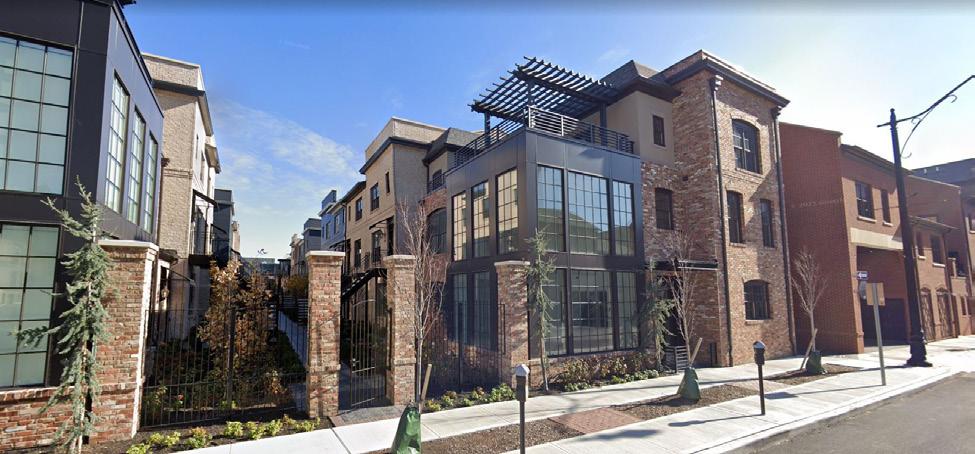
• Development will surface park
• This site has the potential to attract market-rate development with the ability to catalyze future development around the station
• Development of this site would test the application of the denser CD5 zoning with more stringent Town Council approval in the process
Development Program 5.2 Acres Residential 105 Residential Units Mixed-Use (Office/Retail) 54,000 SF
28 Northwest Indiana TDD • TOD Strategic Implementation Plan
Site B2
Hohman Ave
SouthSt
RidgeRd
NORTH
Strack & Van Til Supermarket
Arc of Development
At this level of study, it is difficult to assign exact timeframes to development, but this plan demonstrates a range of development and illustrates a potential arc of development over time that could be possible with the right set of incentives and conditions supported by the market.
To understand the full range of potential of these sites, high-level capacity tests were conducted using various densities and types of development possible for each community. Estimations of several metrics of community impacts, including population changes, school impacts, jobs created, and generated vehicle trips, were calculated based on future potential development. These impacts were informed by market analysis conducted by KPMG and Policy Analytics, ownership status, local guidance and interest, and quantitative and qualitative planning analysis.


The arc of development for each community was defined collectively for selected development opportunities within the TDD boundary that projects future development potential over 5-, 10-, and 20-year time horizons. Quantitative and qualitative factors such as local/public property control, developer engagement or interest, site conditions, current regulations or future regulatory changes, among others were considered in determining the arc of development over time. This study is confident, however, that investments outlined herein can change the outlook and perception of this area and thus induce the private development market over time.
Projected Land Use & Development: 5-Year Horizon

Projected Land Use & Development: 10-Year Horizon
Projected Land Use & Development: 20-Year Horizon
Ridge Rd Manor Ave Hohman Ave West Lake Line Calumet Ave Ridge Rd Manor Ave Hohman Ave West Lake Line Calumet Ave Ridge Rd Manor Ave Hohman Ave West Lake Line Calumet Ave Munster • Ridge Road Station 29
Area Mixed-Use Core Mixed-Use Neighborhood Mixed Residential Employment/Office Industrial/Warehousing
Station
Impact Projections
* Vehicle trips generated include projected commuters in 2022 and in 2040 at full build out
** Source: NICTD
30 Northwest Indiana TDD • TOD Strategic Implementation Plan Land Use Total Development in Acres ±16.53 Acres Total Development in Sq. Ft. ±720,200 SF Mixed-Use Development ±86,000 SF Office Development ±104,000 SF Residential Development ±530,000 SF Residential Housing Units Total Housing Units ±555 Projected Impacts Residential Population Increase ±1,535 Households with School-Aged Children ±280 Employees ±215 Vehicle Trips Generated* ±6,675 (2022)** ±6,690 (2040)**
Infrastructure
Documentation and Analysis
Functional Classifications
Determined by INDOT, functional classifications were documented and used in analysis to understand the hierarchy of corridors in each community. These classifications also helped inform street design and public realm character typologies.
Calumet Avenue is the Principal Arterial through this TDD boundary. Minor Arterials of Ridge Road, Hohman Avenue, and Columbia Avenue disperse traffic from Calumet Avenue to other commercial areas and neighborhoods. Major and Minor Collectors serve to connect residential neighborhoods to each other and to arterials.
The 2021 Calumet-Ridge Streetscape Plan prioritizes pedestrian safety and multi-modal facilities on these two arterial roadways.
31 Munster • Ridge Road Station
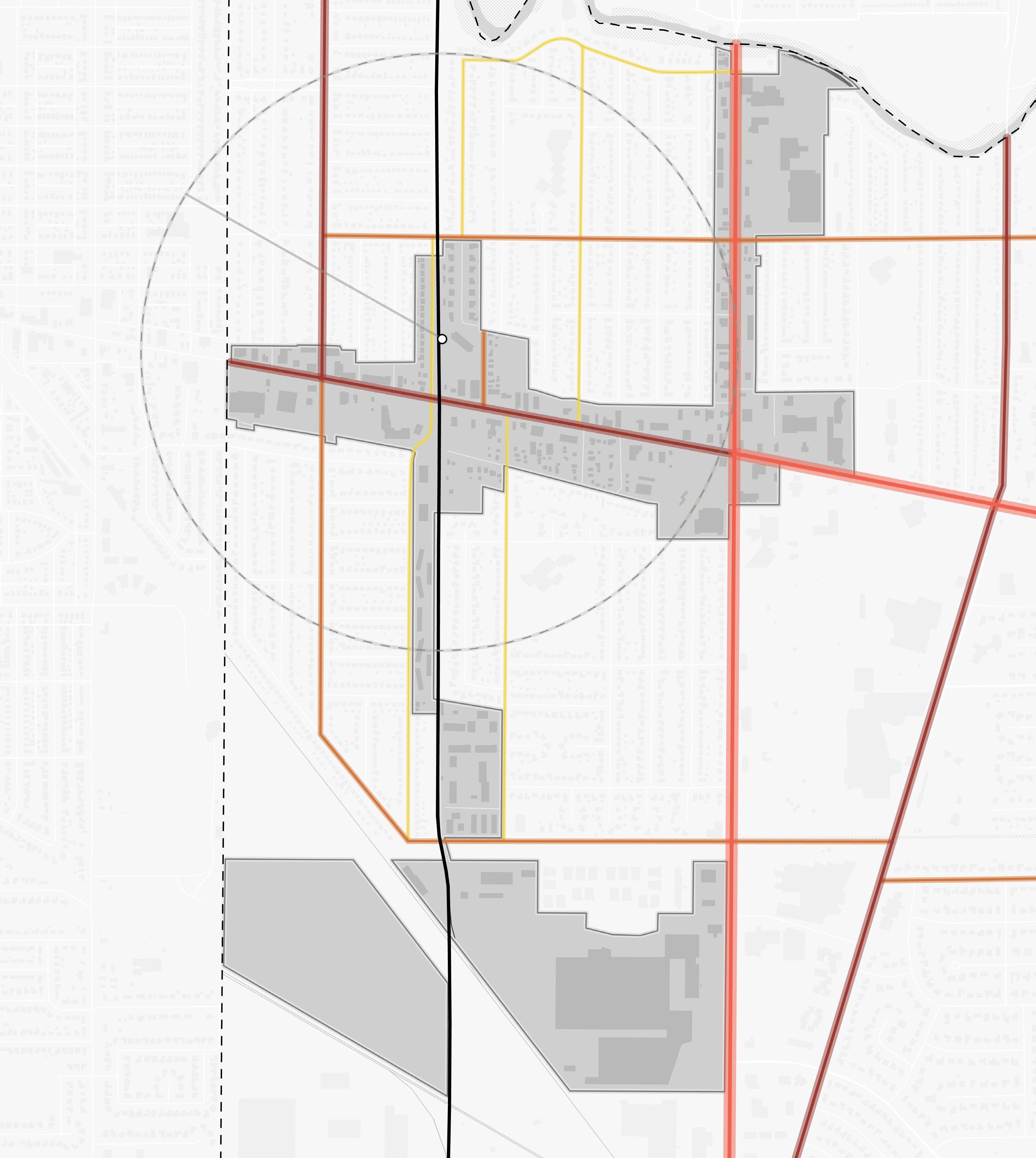
Principal Arterial Minor Arterial Major Collector Minor Collector 32 Northwest Indiana TDD • TOD Strategic Implementation Plan West Lake Line Future Ridge Road Station Munster Christian Church Calumet Center Manor Ave Wentworth Ave INDIANA ILLINOIS State Line 1/2Mile MUNSTERHAMMOND CorporateLimits Little Calumet River Community Hospital Munster High School Broadmoor Ave Harrison Ave Manor Ave Hohman Ave Columbia Ave Ridge Rd Ridge Rd Hohman Ave Fisher St Calumet Ave NORTH Functional Classifications
Thoroughfare Typologies


Ridge Road between the State Line and Calumet Avenue is designated as TOD Priority Thoroughfare as the primary vehicular access point to the future station. Calumet Avenue and Fisher Street serve as TOD Connectors that create easy access to Ridge Road from other high-traffic areas. Broadmoor Avenue, Columbia Avenue, Manor Avenue, and portions of Ridge Road east of Calumet Avenue are designated as Key Vehicular Routes that primarily function to move vehicles through the area. The Ridge Road Station Area benefits immensely from access to both the Pennsy Greenway and the Monon Trail. The West Lake Line is planned to align with the existing Monon Trail through this portion of Munster, and an extension of the trail is being planned that would continue parallel to the West Lake Line toward the Little Calumet River.




Key Pedestrian Route TOD Priority Thoroughfare
Connector Key Vehicular Route Trail/Greenway 33 Munster • Ridge Road Station
TOD

TOD Priority Thoroughfare TOD Connector Key Vehicular Route Existing Trail/Greenway Key Pedestrian Route NORTH 34 Northwest Indiana TDD • TOD Strategic Implementation Plan West Lake Line Future
Station Munster Christian
Calumet Center INDIANA ILLINOIS State Line 1/2Mile MUNSTERHAMMOND CorporateLimits Little Calumet River Broadmoor Ave Manor Ave Columbia Ave Ridge Rd Ridge Rd Fisher St Calumet Ave Calumet Ave Community Hospital Munster High School Pennsy Greenway Monon Trail Thoroughfare Typologies
Ridge Road
Church
TOD Priority
Thoroughfare
Designed as a Complete Street, accommodating all modes of transportation with high-quality facilities, amenities, and public realm



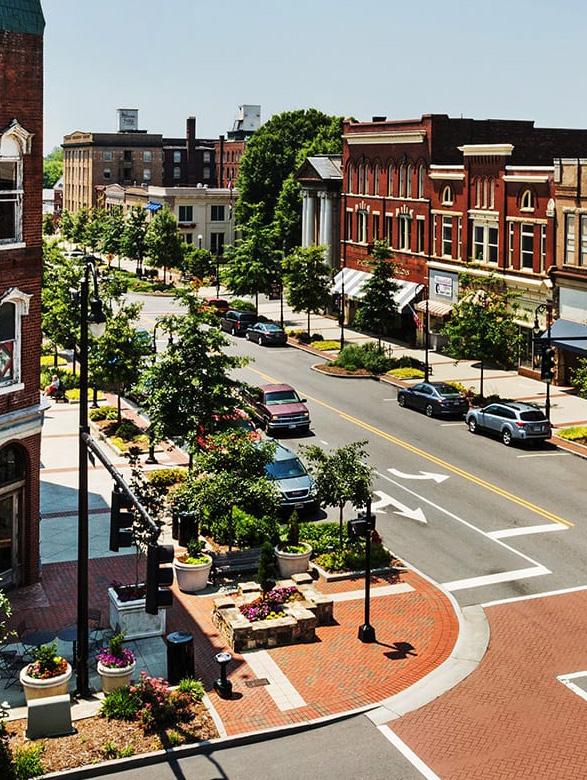
TOD Priority Thoroughfares support the highest intensity of activity, at local and regional scales. The function of these corridors is primarily to provide multi-modal access to the Station Area and to generate street-level activity for a mix of uses. These corridors will likely carry a high volume of traffic, but at lower vehicle speeds to also accommodate safe, highly-walkable conditions for pedestrians and bicyclists. An attractive, high-quality public realm provides abundant amenities for pedestrians and bicyclists, creating a safe and comfortable environment and establishing an identity/ sense of place. Buildings are typically oriented toward the sidewalk with active ground floor uses. Sidewalks should be wide enough to accommodate a clear walking path along with amenities such as street trees, planters, landscaping, outdoor dining, and gathering areas. Transit is also highly accessible along TOD Priority Thoroughfares, and transit stops should be enhanced and designed as part of the public realm. Parking is typically provided on-street, and access to development blocks or off-street parking should not occur directly from the corridor.

Ridge Road Station
Number of Lanes/ Target Speed
Non-motorized Facilities
Bus/transit Facilities
Parking
Access Management
Public Realm Design/Amenities
2-4 lanes / 25-35 mph
Dedicated facilities (dedicated/separated bike lanes, sharrows, multi-use paths) wide sidewalks; frequent crossings that are well-designed and enhanced for safety and access, including mid-block crossings where necessary

Well-served by bus/transit; enhanced transit stops including shelters and other amenities; Station Area as a hub for transit facilities; bus pull-off or drop-off zones encouraged
On-street parking; any off-street parking, either structured garages or surface lots, should be to the rear of buildings, interior to blocks, and/or properly screened and well-designed with landscaping
Very limited to no driveways in the TOD Station Area; shared parking among buildings and uses is highly encouraged to reduce the number of driveways; driveways, if present, should be adequately spaced and offset to prevent conflicts; consolidation of existing driveways should be studied
High quality and active public realm design with abundant amenities for pedestrians and bicyclists; design should be reflective of the community character and identity; sidewalks should provide adequate clear space for pedestrian circulation
36 Northwest Indiana TDD • TOD Strategic Implementation Plan
TOD Priority Thoroughfare
TOD Connector
Multi-modal street that balances modes of transportation to connect to other major facilities, with high-quality public realm and frequent amenities



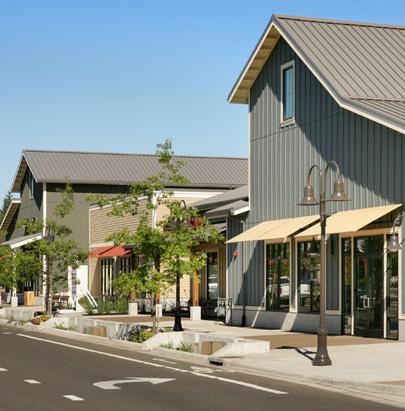
TOD Connector Thoroughfares may vary more in density of development and intensity of uses, depending on the context. These corridors serve to provide access to TOD Priority Corridors, transit-oriented development and the Station Area for the broader community and connect to other key destinations. TOD Connectors are multi-modal in design with lower vehicular speeds, connected pedestrian and bicycle networks, and transit stops. Bicycle infrastructure may vary from dedicated facilities to shared streets, depending on available right-of-way. A high-quality public realm should continue along these corridors, but may be less intense or frequent in amenities depending on right-of-way and context. Buildings are typically oriented toward the sidewalk with active ground floor uses, but setbacks may increase with a decrease in density. Driveways, both residential and commercial, may be present along the corridor, but infrequent; access management should ensure safe entry/exit along the corridor. Parking is typically provided on-street, and access to development blocks or off-street parking should not occur directly from the corridor.

Number of Lanes/ Target Speed
Non-motorized Facilities
Bus/transit Facilities
Parking
Access Management
Public Realm Design/Amenities
2-4 lanes / 25-35 mph
Connecting gaps of existing facilities (dedicated/separated bike lanes, sharrows, multi-use paths, sidewalks, well-designed and enhanced crossings); enhancing existing facilities to improve safety and accessibility
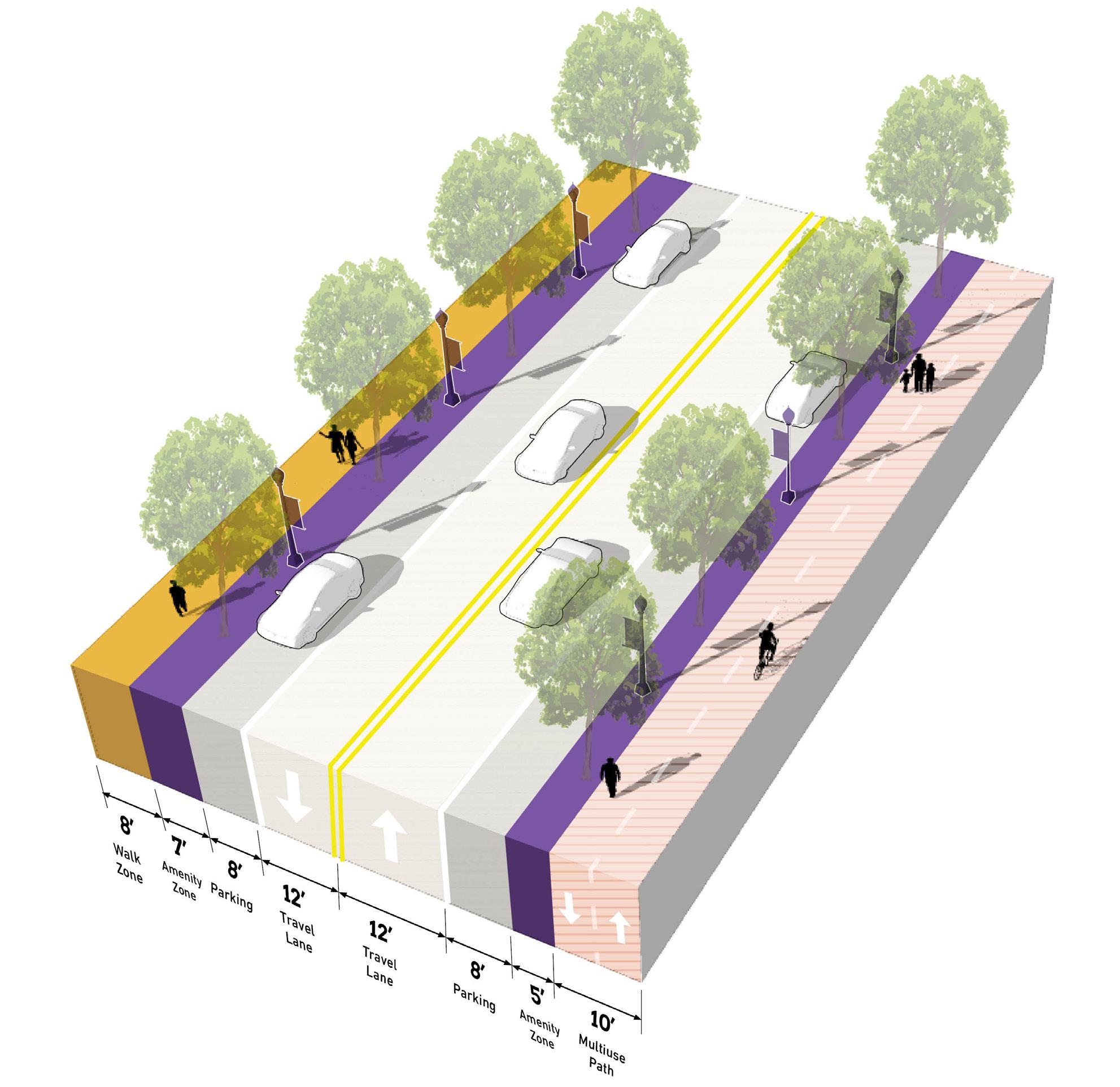
Well-served by bus/transit; enhanced transit stops including shelters and other amenities; bus pull-off or drop-off zones encouraged
On-street parking; any off-street parking, either structured garages or surface lots, should be to the rear of buildings, interior to blocks, and/or properly screened and well-designed with landscaping
Limited driveways along corridor; shared parking among buildings and uses is highly encouraged to reduce the number of driveways; driveways, if present, should be adequately spaced and offset to prevent conflicts; consolidation of existing driveways should be studied
High quality and active public realm design with many amenities for pedestrians and bicyclists; design should be reflective of the community character and identity; sidewalks should provide adequate clear space for pedestrian circulation
38 Northwest Indiana TDD • TOD Strategic Implementation Plan
TOD Connector
Key Vehicular Route
Primarily functions for vehicular travel but ensures adequate access and safety for all other modes along the corridor, connects to other facilities in the community




Key Vehicular Routes serve areas of moderate density and transition areas to more residential or neighborhood scale areas of the community. These corridors are more auto-oriented, linking residents to major community destinations, services, and amenities, but should still contribute to the network of safe and comfortable pedestrian and bicycle facilities. Transit service may be less frequent on these thoroughfares, but should still be accessible to important transit routes. Vehicular speeds are low along these thoroughfares, and the public realm may be less formal in design, especially in residential areas. However, quality design should still contribute to a sense of place along these corridors. On-street parking may exist in denser areas, and residential and commercial driveways are more frequent along Key Vehicular Routes, especially in more suburban-style development areas. New development should establish a high level of public realm and prevent or mitigate any vehicular conflicts through access management interventions. Parking is typically provided on-street, and access to development blocks or off-street parking should not occur directly from the thoroughfare.

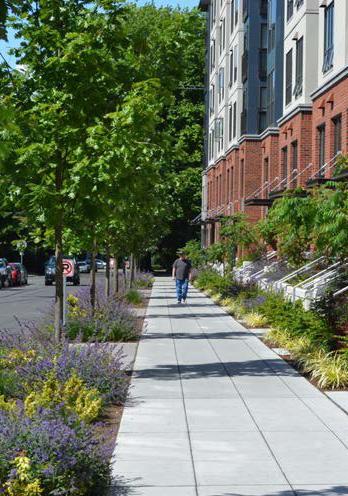
Number of Lanes/Target Speed 2 lanes / 20-25 mph
Non-motorized Facilities
Connecting gaps of existing facilities and access to enhanced facilities (sharrows, multi-use paths, sidewalks, well-designed and enhanced crossings); focus on balancing of modes

Bus/transit Facilities
Some bus/transit facilities, less frequent but enhanced transit stops; stops should be located at key destinations
Parking
On-street parking; any off-street parking, either structured garages or surface lots, should be to the rear of buildings, interior to blocks, and/or properly screened and well-designed with landscaping (if visible from corridor)
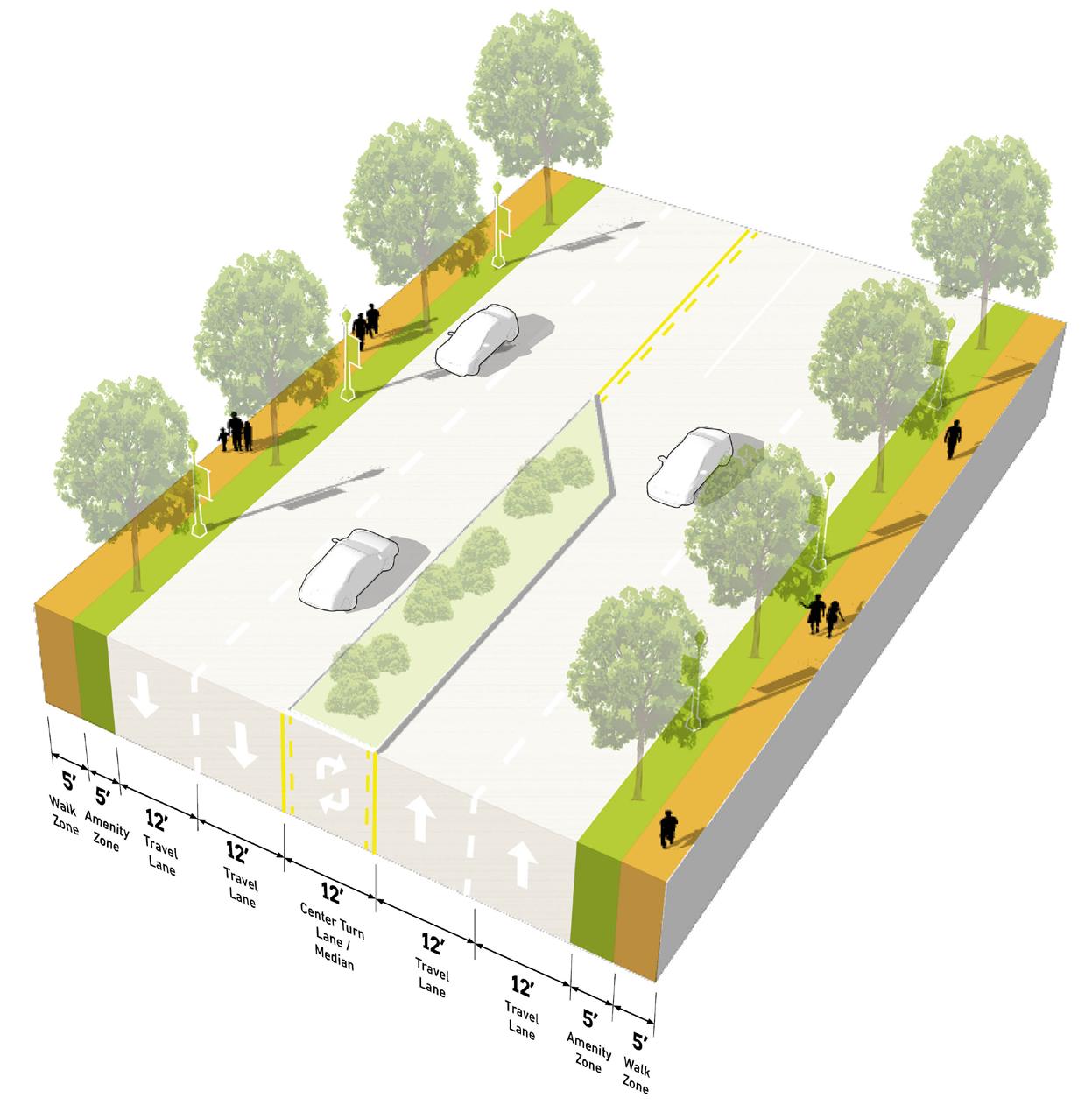
Access Management
Public realm design with basic amenities for pedestrians and bicyclists; design should be reflective of the community character and identity; sidewalks should provide adequate clear space for pedestrian circulation
Public Realm
Design/ Amenities
High quality and active public realm design with many amenities for pedestrians and bicyclists; design should be reflective of the community character and identity; sidewalks should provide adequate clear space for pedestrian circulation
40 Northwest Indiana TDD • TOD Strategic Implementation Plan
Key
Route
Vehicular
Key Pedestrian Route
Functions primarily for pedestrians, typically as a highly-designed pathway or as a trail or greenway, and may also accommodate bicyclists



Key Pedestrian Routes primarily serve pedestrians to connect to key destinations, transit access, and the Station Area. These routes may exist alongside vehicular corridors or they may exist in the form of a pedestrian pathway or trail. In the case of a trail, bicycles may also be accommodated. Amenities and landscaping should be designed at pedestrian-scale and either contribute to the surrounding character or to particular brand if part of a larger trail network. Wayfinding and signage is particularly important to highlight access points and destinations across the community. New Key Pedestrian Routes should be planned to avoid vehicular conflicts such as driveways, and these conflicts should be reduced to the extent possible along existing Key Pedestrian Routes.


Number of Lanes/Target Speed N/A or Varies
Non-motorized Facilities
Completing gaps of existing facilities and access to enhanced facilities (sidewalks, multi-use paths, and well-design and enhanced crossings where intersecting with roadways); may exist along roadways or as a separated facilities like a path or trail

Bus/transit Facilities
Some bus/transit facilities, less frequent but enhanced transit stops; stops should be well-connected by a complete network of pedestrian facilities

Parking
Parking areas, on-street or off-street, should be located near trailheads. Pedestrian routes may connect parking areas to other destinations in the community.
Access Management
Limited driveways intersecting with pedestrian routes to reduce conflicts with vehicle entries/exits and maximize pedestrian safety. New pedestrian routes should be planned along corridors with minimal driveway conflicts, or access management interventions may be implemented.
Public Realm Design/ Amenities
Amenities along pedestrian routes should be tailored to pedestrians (or bicyclists if a multi-use path or trail); design should be reflective of the community character and identity;local or regional trails may be designed with individual branding
42 Northwest Indiana TDD • TOD Strategic Implementation Plan
Key
Route
Pedestrian
Engineering & NICTD Coordination
Throughout this process, this team collaborated closely with Town of Munster and NICTD to understand the Ridge Road Station design parameters, stormwater negotiations, and conditions for the Monon Trail extension.
The team focused primarily on analyzing development potential tied to existing utility capacity in the Ridge Road Station Area. This analysis supplements the work conducted as part of the Town’s 2021 Calumet-Ridge Streetscape Plan and to address concerns about the ability for existing infrastructure to support mixed-use TOD along Ridge Road.
This detailed analysis confirmed that public utility upgrades to water, sanitary sewer, and storm sewer are not required for TOD to occur. Capacity calculations associated with each of the (3) conceptual development alternatives resulted in a minimum 8-in diameter sanitary sewer, 12-in diameter storm sewer, and 8-in diameter water main required to accommodate future conditions. Engineering analysis identified sufficient public infrastructure to support TOD as envisioned in this plan. Development costs included at the end of this plan include tie-ins from private property to existing utility infrastructure. It is anticipated that the developer will bear these costs and not the Town.
43 Munster • Ridge Road Station
Zoning
Existing Zoning Districts
The table below lists the existing Zoning Districts within the TDD Boundary area, along with their descriptions.
District
CD-5 Urban Center
CD-4.B General Urban - B District
Description
Higher density mixed use areas; has a tight network of thoroughfares with side sidewalks, street lights and regular tree spacing, defining medium-sized blocks; buildings are set close to the sidewalks
Medium density area that has a mix of building types and primarily residential, retail, personal service, office, and light industrial uses; setbacks vary as compared to CD-4.A; it has variable private and public open spaces and landscaping; thoroughfares typically have curbs, sidewalks and trees; blocks may vary in size to accommodate a variety of uses
CD-4.A General Urban - A District
Medium density area that has a mix of building types and primarily residential, retail, personal service, and office uses; there are medium, shallow or no front setbacks and narrow to medium side setbacks; it has variable private landscaping; and has thoroughfares with curbs, sidewalks and trees that define medium-sized blocks
CD-4.RA Multifamily Residence District
Primarily a medium density attached residential area in which apartment houses are the predominant building type; has medium to deep front setbacks and medium to wide side setbacks; most thoroughfares have sidewalks, street trees and curbs; medium to large blocks
CD-3.R2 Neighborhood - 60’ Lot One Family Residence District
CD-3.R3 Neighborhood - 60’ Lot One Family and Two Family Residence District
SD-PUD Planned Unit Development
Primarily a low density single-family detached residential area in which houses are the predominant building type; has some medium to deep front setbacks and medium to wide side setbacks; some thoroughfares have sidewalks and curbs, and form medium to large blocks
Primarily a low density single-family detached residential area in which houses and two-family dwellings are the predominant buliding types; has medium to deep front setbacks and medium to wide side setbacks; most thoroughfares have sidewalks, street trees and curbs, and form medium to large blocks
For areas in which diverse uses may be brought together with innovative planning and design as a compatible and unified plan of development that is in the interest of the general welfare of the public
CZ Civic Zone Areas designated for civic purposes; may be open space of one or more civic space types allowed within or adjacent to any specific character district or special district, as well as sites dedicated to significant buildings to be used for civic purposes, such as town halls, post offices, libraries, places of assembly, places of worship, and community centers
SD-M Manufacturing
For light industrial development compatible with a limited residential community; intended to encourage development with suitable uses, space, landscaping, and parking areas
Note: In all districts, mixed-use is a conditional use that requires council approval.
45 Munster • Ridge Road Station

CD-3.R1 CD-3.R2 CD-3.R3 CD-3.R4 CD-4.A CD-4.B CD-5 SD-M CZ SD-PUD CD-5 CD-5 SD-PUD CZ CD-4.B CD-3.R2 CD-3.R2 CD-3.R2 CD-3.R3 CD-3.R3 CD-4.A CD-4.A CD-4.A CD-4.A CD-4.R4 CD-4.R4 CD-4.R4 CD-4.A 46 Northwest Indiana TDD • TOD Strategic Implementation Plan West Lake Line Future Ridge Road Station Community Hospital Munster High School Calumet Center Ridge Rd Calumet Ave Calumet Ave Harrison Ave Manor Ave Manor Ave Hohman Ave Hohman Ave Wentworth Ave Fisher St Columbia Ave Columbia Ave INDIANA ILLINOIS State Line Broadmoor Ave 1/2Mile MUNSTERHAMMOND CorporateLimits Little Calumet River Munster Christian Church NORTH Existing Zoning Districts
Existing Zoning Metrics
Some of the primary metrics that were taken into account in the analysis are provided in the table.
47 Munster • Ridge Road Station District Height (max) Lot Coverage Min. Lot Area Min. Lot Width Min. Front Setback CD-5 Urban Center principal building 6 stories 80% max N/A 18 ft 0 ft at corners unless setback is required for sight lines accessory building 2 stories CD-4.B General Urban - B District principal building 50 ft or 4 stories 70% max N/A 18 ft 0 ft accessory building 35 ft or 2 stories CD-4.A General Urban - A District principal building 50 ft or 4 stories 70% max N/A 18 ft 0 ft accessory building 35 ft or 2 stories CD-4.RA Multifamily Residence District 50 ft or 4 stories 30% max; accessory structures shall not exceed 900 sq ft 4500 sq ft N/A 1 ft in least dimension for each 1 ft in height of the principal building or 40 ft, whichever is greater CD-3.R2 Neighborhood - 60’ Lot One Family Residence District dwellings 5000 sq ft or more 39 ft 30% max; accessory structures shall not exceed 900 sq ft 9000 sq ft 60 ft avg. 1 ft in least dimension for each 1 ft in height of the principal building or 35 ft, whichever is greater dwellings less than 5000 sq ft 2.5 stories or 35 ft other structures 4 stories or 50 ft CD-3.R3 Neighborhood - 60’ Lot One Family and Two Family Residence District dwellings 5000 sq ft or more 39 ft 30% max; accessory structures shall not exceed 900 sq ft lots intended for two-family dwellings 4500 sq ft; all other lots 7500 sq ft 60 ft avg. 1 ft in least dimension for each 1 ft in height of the principal building or 35 ft, whichever is greater dwellings less than 5000 sq ft 2.5 stories or 35 ft other structures 4 stories or 50 ft SD-PUD Planned Unit Development per PUD approval per PUD approval per PUD approval per PUD approval per PUD approval CZ Civic Zone principal building may be 20 ft higher than max height of any adjacent character district N/A N/A N/A 0 ft; 50% of lot depth max other structures 30 ft SD-M Manufacturing 4 stories or 50 ft 20,000 sq ft non-arterial street: 35 ft from street; arterial street: 50 ft from street or 1 ft for each ft of building height
Codes and Recommendations
The current zoning adequately supports TOD principles for the Ridge Road Station. Reduction in parking requirements or stricter parking maximums should be considered.
TOD Principles Evaluation Recommendation
Employment Center
The CD-4.B and CD-5 districts allow for a mixture of uses including office, with light industrial being allowed in CD-4.B.
The boundaries of the districts may need to be adjusted depending on the location for the employment center.
Mixed-Use Center
The CD-5 zoning at the station area allows for the type of development that would be found in a mixed-use town center and the higher levels of activity associated with the station.
The current zoning is appropriate to create a mixed-use town center at the station area.
Neighborhoods
The CD-4.R4 Multifamily Residence District creates a transition along the rail line to the east to the CD-3 neighborhoods.
The current zoning is appropriate to encourage development that incorporates appropriately-scaled residential opportunities that step down in scale to blend with the single-family neighborhood fabric to the east of the rail line. A transition from CD-5 to CD-3 should be considered for the properties at the station area.
Parking The zoning provides shared parking requirements and maximums of 10% over the minimum, but does not provide TOD parking reductions.
The parking requirements should be updated for TOD parking reductions.
The Town requested sensible parking standards for the Ridge Road Station Area. Currently, Town officials feel that on-street parking is highly underutilized. They are concerned that as new development occurs, areas will require too much parking to be constructed which will add to cost and land requirements. Revised parking standards are located in the Appendix.
Note: In all districts, mixed-use is a conditional use that requires council approval.
48 Northwest Indiana TDD • TOD Strategic Implementation Plan
Implementation
Implementation Strategies
While planning efforts are inherently long-range in scope, there is a benefit to identifying early projects – catalyst projects – that are necessary to improve market conditions and spark changes. This is where a development plan becomes more tangible with near-term goals that can be brought into sharper focus for the community and achieved relatively quickly to create momentum into the future.
Critical components of an implementable development plan include site capacity, economic viability, and political support. The implementation strategy summarizes project recommendations contained within this plan and an explanation of associated infrastructure project costs that can be used to develop a capital projects plan that supports TOD. This process is aimed at providing implementable steps and technical resources for the community to advance and adopt in preparation for TOD in accordance with its growth path.
Implementation strategies are outlined in three timeframes and are defined below: Immediate Next Steps, Short-Term Strategies, and Long-Term Strategies.
Immediate Next Steps
Actions to take quickly to get recommendations set up for implementation
Short-Term Strategies
Tasks and projects that can be executed in a 1-5 year timeframe
Long-Term Strategies
Tasks and projects that require additional work to execute and can be completed in 5 or more years
Enabling Actions
• Host an educational session “road show” with the Northwest Indiana RDA inviting elected and appointed officials and residents to share the purpose of this effort; the positive community impacts that can occur within the TDD boundary; and the potential to create walkable, vibrant TOD that will attract new investment, population, businesses, and employment opportunities
• Meet with Town staff and consultants to review recommendations provided in this Ridge Road TOD Implementation Strategy as the community proceeds in its Comprehensive Plan update
• Use recommendations and illustrations within this plan for funding requests/applications for NIRPC, READI, Next Level Trails, and other state, federal, and philanthropic grant opportunities that highlight the comprehensive thought and partnerships behind this effort
• Collaborate with the RDA to understand how projects could be funded through TDD increment dollars as revenue begins to flow into the TDD fund in 2024
Land Use & Zoning
Immediate Next Steps
• Create a working group of Munster staff and Plan Commission members to review the zoning recommendations associated parking standards included in this TOD strategy. Bring this draft information to the working group to further evaluate next steps for updates to the Town’s Zoning Ordinance.
Short-Term Strategies
• Review and integrate relevant and supported land use and development recommendations within this plan into the Town’s comprehensive planning process
• Update the Town’s Zoning Ordinance with the new parking standards included in the Appendix
• Use the Town’s Comprehensive Plan update to evaluate the potential for redevelopment in the Ridge Road area over time and determine highest and best use for properties in support of the Town’s economic growth path
49 Munster • Ridge Road Station
• Share this TOD and TDD vision with land owners; interested parties; developers; investors; and local, state, and regional economic and housing agencies. Build excitement and support to attract the desired investment to the Ridge Road Station Area.
(Re)development
Immediate Next Steps
• Reconvene conversations with developers that attended Industry Day and share the TOD vision. Try to attract developers to this area who might be looking for a unique opportunity to partner with the Town and align with its vision for future development.
Short-Term Strategies
• Support/embrace the new Imagine Ridge Road Project.
• Support the development of Site B2 (former Jones Clinic) as the first potential mixed-use TOD redevelopment site in the Ridge Road district using the recently updated Zoning Ordinance.
• Support the development of Site E (former Lansing Country Club) as an employment use with connections to the station area. Once development occurs, evaluate the potential for a shuttle bus between the station and the development for commuters.
• Confirm utility upgrades needed for full and phased TOD build-out as suggested by this study
• Use the Arc of Development study to advance conversations with the community and other major stakeholders about the potential for revitalization tied to TOD, including population growth, job creation, economic development through TDD revenue
• Pair development projections included within this TOD strategy with anticipated population increase to balance development potential with costs of infrastructure Town personnel over time
• Promote housing types such as townhomes and small scale buildings that respect the existing character of the neighborhoods
• Promote sustainable design through adaptive re-use or the use of local, durable and/or recycled building materials, permeable pavement, electric charging stations and solar panels, shared parking strategies, and native plant species
Long-Term Strategies
• Once the Town completes its Comprehensive Plan update and the West Lake Line is operational, consider other development sites recommended within this TOD strategy as interest occurs in the community. Develop these sites in accordance with the Town’s Zoning Ordinance with an emphasis on walkability and mixed-use development concentrated within a ¼ mile of the station.
• Evaluate the need for a strategy to preserve historic rowhouses near the station if teardown/ rebuild begins to occur as property values rise as a result of the West Lake Line
Transportation & Mobility
Short-Term Strategies
• Conduct a sidewalk and trail conditions assessment to determine where improvements are needed to connect the community to the Ridge Road Station
• Support first- and last-mile connections to the station, such as upgraded sidewalks, ADA ramps, and bike/scooter share programs
Long-Term Strategies
• Coordinate with NICTD on potential long-term joint development of the Ridge Road Station parking lot as mixed-use development wrapping structured parking serving residents/visitors to the site and commuters
Community Building & Identity
Immediate Next Steps
• Brand the Ridge Road business district/TOD as streetscape improvements are implemented
• Employ an Equitable Development Toolkit to model impactful and inclusive growth on catalytic sites. Prioritize support for projects which:
• Redevelop housing stock with typologies currently found throughout Town
• Increase the assessed valuation of the Town
• Create pathways to community wealth-building
• Invest in the public realm and promote authentic identity tied to place
• Support the growth of a thriving locally-owned business community and startups
50 Northwest Indiana TDD • TOD Strategic Implementation Plan


INDIANA INDIANA MICHIGAN ILLINOIS 94 94 80 65 Lake Michigan Hammond Gateway East Chicago Gary Metro Center Miller Portage/ Ogden Dunes 11th Street South Bend Dune Park Beverly Shores Ridge Road Main Street











































































